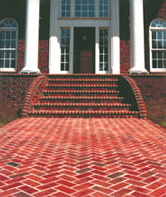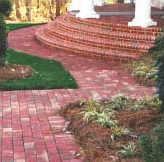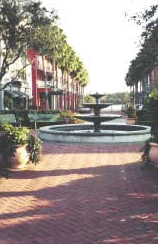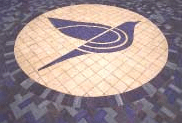Paving Options: From Clay to Beyond
By Tom Perry
 How can a mason contractor move a residential or commercial client away from hiring a landscaper when the customer wants paving installed? By adding paving to the contractor's portfolio, of course.
How can a mason contractor move a residential or commercial client away from hiring a landscaper when the customer wants paving installed? By adding paving to the contractor's portfolio, of course.
Your customer wants meandering garden paths, sidewalks going from here to there, a circular driveway, a relaxing back patio ? any or all of these can be part of a landscape design. The problem arises when the client turns to a landscaper, not a mason contractor, for the results. If you don't offer paving products and services, that landscaper can be pulling profits from your company.
In your portfolio, you should offer the services needed to install pavers and other hardscape features. Adding the catalogs of reliable paver producers to that portfolio will increase your profit potential. Remember, the paving materials you choose will, in large part, determine the personality of the hardscape you install. Tom Perry of the Brick Industry Association explains the differences in pavers available for that portfolio.
The choices in paving materials range from genuine clay paving products ? also known as brick pavers ? to concrete products (poured, stamped or brick-shaped), natural stone products such as flagstone, and tile products like slate. Some are more appropriate than others for certain areas, and, of course, they all have their own unique character. Let's look at the products themselves and see how they compare.
Genuine Clay Pavers
New brick paver products provide countless aesthetic choices, while still offering the time-honored durability of a product that's been around for, literally, thousands of years. Genuine brick pavers, made from a blend of clay and shale, are dried and fired at nearly 2,000 degrees Fahrenheit, making them so strong that they can withstand loads exceeding 12,000 pounds per inch.
The rich, lasting color of clay pavers is one of the biggest aesthetic benefits of the product. Because the color is inherent to the clay ? not added as an artificial dye or pigment ? it will never fade. And because the colors are natural earth tones, they blend seamlessly into any outdoor landscape. Indeed, what could be a more natural ground covering than a product made from the earth itself.
Although the colors of genuine clay pavers are all naturally occurring earth tones, Mother Nature is quite generous with her palette. Pavers range from the lightest buff to the darkest charcoal and deepest chocolate. A variety of traditional reds and more subtle pinks are also available. Clay paver colors can even reflect minerals ? like iron ? found in clay and shale deposits, giving them strong, metallic undertones.
 Brick pavers come in several different shapes and sizes, including many rectangular sizes (the most common), a boardwalk paver (long and narrow, like a boardwalk plank), interlocking octagonal and odd-shapes, and even a bull nose with a curved edge perfect for overhangs on steps and other niche areas.
Brick pavers come in several different shapes and sizes, including many rectangular sizes (the most common), a boardwalk paver (long and narrow, like a boardwalk plank), interlocking octagonal and odd-shapes, and even a bull nose with a curved edge perfect for overhangs on steps and other niche areas.
Textures and installation options (mortar or sand) are other ways to customize a clay paving project. For the most formal look, choose extruded pavers that are very consistent and angular, set in mortar to achieve a smooth, precise appearance. To add instant old world charm, to create a more rustic look, or for casual entertaining areas, consider molded pavers (formed in wood molds or tumbled after manufacturing) set on a sand bed.
Clay pavers, like face brick used on a home, require very little maintenance and can be expected to last a lifetime. Brick streets in Boston, still in use after more than 200 years, are a testament to their longevity. Cleaning, when necessary, is easily accomplished with a little detergent and a water hose.
Concrete Pavers
Designed to mimic clay brick pavers, concrete pavers consist of cement and aggregate dyed to the desired shade. Like brick pavers, concrete pavers can be found in a variety of styles. However, the color choices are fewer and color retention is sometimes tricky.
The pigment added to concrete pavers can erode, eventually exposing the color of the sand or aggregate and perhaps a complete change from the original color of the concrete paver. Dark pigments in particular can fade over time. Unfortunately, once the color has faded, it is impossible to bring the color back to its original appearance without replacing the concrete paver.
Fortunately, all pavers can be removed and re-installed relatively easily, especially when using the sand bed method of installation. Another alternative to correcting color fades is the application of a colored sealant, which may be used to create a new look at an additional cost.
Poured and Stamped Concrete
Poured concrete allows a versatility ranging from a large, low-cost slab or a more costly, yet intricate, pattern achieved through stamping, a newly popular technique in which patterns designed to resemble other products, such as brick, slate, flagstone, etc. are, literally, stamped into wet concrete treated with the appropriate color of pigment. Joints are used to control cracking and as a separator for fairly uniform panels, which can be created in a wide variety of patterns and colors.
 Although inexpensive, traditional poured concrete is not often the top choice simply because of aesthetic limitations. Concrete is most often used in its natural, gray color, which often isn't the best fit for a hardscape design. While pigments can be added to achieve a range of colors, the pigment is not permanent and can be expected to fade over time. Stamped concrete, with many more textural options than plain poured concrete, may still be relatively inexpensive to install; however, it may prove pricier in the long run than the brick products it aims to substitute because of maintenance requirements.
Although inexpensive, traditional poured concrete is not often the top choice simply because of aesthetic limitations. Concrete is most often used in its natural, gray color, which often isn't the best fit for a hardscape design. While pigments can be added to achieve a range of colors, the pigment is not permanent and can be expected to fade over time. Stamped concrete, with many more textural options than plain poured concrete, may still be relatively inexpensive to install; however, it may prove pricier in the long run than the brick products it aims to substitute because of maintenance requirements.
For any concrete hardscape, it is also important to clean and seal the final product, particularly if it is stamped or colored. Sealers help defend the stamped concrete against weather, water and stains. Prior to sealing the surface, it must be completely clean ? no dust, oil, or other debris ? and if you wait too long the color may begin to lighten even before the initial sealant is applied.
Those who use this type of material must also make certain that the newly poured concrete is not too wet. This may mean additional waiting time for some of the water to evaporate, or too dry, which makes for an unsteady stamping depth. If too few workers are responsible for a large project, they may be forced to begin stamping right after the concrete is poured and very wet and finish when it's too dry, resulting in inconsistent stamping.
Natural Stone and Stone Tile
Stone, a solid formed by nature itself from one or more minerals, can ? like clay pavers ? provide an organic look to complement a landscape. However, because of strength limitations and inconsistent sizes, the areas for which you choose to use stone will be somewhat more limited than with other paving products. It's a good choice for quaint steps dividing close gardens or for pathways gently curving around the main features of a landscape design.
The possibilities are plentiful with stone as there are quarries all over the world and literally thousands of types available. Stone colors range from black and brown to red and yellow. Minerals enhance the color of stones by imparting variations such as pearlescent, metallic gray and black, pale gold and pink. Stone may be fabricated into natural shapes of varying thickness or cut into more precise pieces to form tiles. Textures range from smooth matte or high gloss, to ultra rough and rustic. Stone also varies in hardness and density, which effects its ability to resist cracking and staining. Stone may be installed in a sand bed, set in mortar or placed directly into the earth as steps.
 Whether your client is leaning toward one of the popular slates or flagstones or something more exotic, research is key to choosing the best stone for landscaping. Stone normally fluctuates in thickness, from 1.5 to 2.25 inches. Although stone tile might make for easier installation and a more precise appearance, it may not perform as well as other products in heavy traffic areas as it is more likely to break under pressure and is not an option for areas such as driveways, which will see vehicular traffic.
Whether your client is leaning toward one of the popular slates or flagstones or something more exotic, research is key to choosing the best stone for landscaping. Stone normally fluctuates in thickness, from 1.5 to 2.25 inches. Although stone tile might make for easier installation and a more precise appearance, it may not perform as well as other products in heavy traffic areas as it is more likely to break under pressure and is not an option for areas such as driveways, which will see vehicular traffic.
Maintenance should also be considered. Not only does stone cost a little more initially but many stones take unique care and require special sealants to prevent staining and enhancers to draw colors out. If you want to offer a truly "au naturel" look (like with informal garden stepping stones), you can forgo the sealant and let nature add its own patina over time.
Making the Decision
In the end, aesthetics and performance must be balanced with cost when considering any of the above-mentioned products. In general, including materials and labor only, the traditional poured concrete patio is the least expensive at around $5 a square foot. Stamped concrete adds additional labor costs and additional costs for sealant, whether colored or clear, making the initial cost around $7 per square foot. Remember that the sealant must be reapplied regularly (every six months to two years) and that cost factored in to your client's long-term budget.
Clay pavers can cost anywhere from $17 to $20 per square foot, while concrete pavers run $15 to $25 a square foot. However, the maintenance cost of clay brick is virtually non-existent ? just the cost of a little detergent ? while concrete pavers may need replacing or sealing to keep color from leaching out. Again, customers should factor this in when looking at the lifecycle cost of their chosen paving material.
The chart below summarizes the characteristics of all of the paving materials covered in this article.
Landscape design today, as with fashion and interior design, leaves much more room for creativity than in the past. Don't be afraid to mix mediums when creating a landscape design. It is perfectly acceptable to have a flagstone path leading to a covered entrance area tiled in slate that transitions to a patio and driveway paved in clay brick.
Choose the product (or products) that best suits your client's needs. And don't forget to look past installation day to the long-term performance and cost of the paving product you're considering offering. In general, natural materials, like clay pavers, tend to age better than artificial ones. In fact, like a fine wine, they actually improve with age, taking on a rich patina that adds character and charm to any hardscape.
| PRODUCT | APPLICATIONS | COLOR | MAINTENANCE | COST** (Per sq. ft) |
| Clay Pavers | All* | Varied and natural (permanent) | Minimal (soap & water) | $17 to $20 |
| Concrete Pavers | All* | Varied with artificial pigment (will fade) | Regular cleaning and resealing | $15 to $25 |
| Poured Concrete | All* | Gray (permanent) or artificial pigment (will fade) | Low if natural gray color / regular cleaning and sealing if colored | $4 to $6 |
| Stamped Concrete | All* | Varied with artificial pigment (will fade) | Regular cleaning and resealing | $7 to $12 |
| Natural Stone | Paths | Varied and natural look (permanent) | Minimal for a natural look / sealing for a more polished | $30 to $35 |
| Stone Tile | Non-vehicular applications, particularly covered outdoor areas | Varied and natural (permanent) | Initial sealing / periodic resealing and minimal ongoing (soap and water) | $9 to $28 |
| * Any hardscape including, but not limited to, sidewalks, garden paths, driveways, patios and porches. ** Includes professional installation |
||||
About the Author
Tom Perry is the Vice President of Marketing for the Brick Industry Association.
Photos courtesy of Pine Hall Brick


















